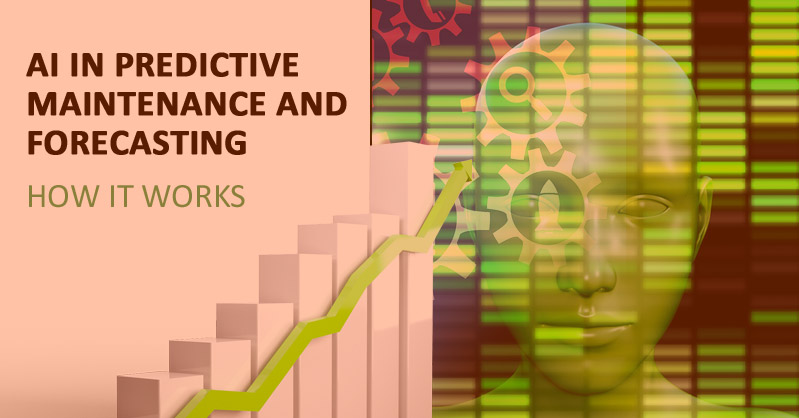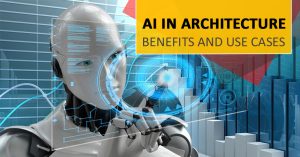
AI in Predictive Maintenance and Forecasting
Industry 4.0 is taking every industry by storm with unprecedented advancement with innovative technology solutions. Its key technologies such as automation, AI, ML, Data Analytics and IoT enables industries to drive business operations with automated data-driven intelligence. Integrating the physical and digital systems, the manufacturing industry is increasingly adopting intelligent manufacturing in this Industry 4.0 era.
What is Predictive Maintenance?
Predictive maintenance is an advanced tech solution for industries to assess and analyze the health of machines, pieces of equipment and processes by collecting, analyzing, and processing data from various real-time sources. Leveraging intelligent algorithms coupled with industrial IoT devices, industries utilize data analytics tools to predict device failures before they happen. The pivotal role of predictive maintenance is to monitor the production processes and machines of different units and share the data with the system to analyze the scenarios/conditions in real-time and for the future. Thus it enables to act on information in real-time using advanced algorithms and machine learning. As a result, predictive maintenance is at the heart of industrial innovation that allows industrial maintenance strategy to be re-optimized from top to bottom to reduce cost, save time and improve productivity. Here’s how companies are adopting this new approach:
- NEED IDENTIFICATION: Initially, identify the best use cases for your business and then understand the areas where maintenance methods can be applied to focus on maintenance costs, inefficiency, and industrial waste.
- DATA ACQUISITION: The rise of IoT plays a dominant game in predictive maintenance, especially with sensors and advanced data storage platforms. Data from programmable controllers, production execution systems, building management systems, and manual data from human inspections are also important. Other sources of data include weather, geographic data, historical usage data, and room configuration.
- DATA CLEANSING AND EXPLORATION: Find out what all the data means and where it comes from before diving deep. Explore and clean data sets to understand what’s going on and how effectively data can be used.
- DATA ENHANCEMENT: Manipulating data at this stage means adding more features and connecting them in meaningful ways to analyze each data from several sensors appropriately.
- DATA PREDICTIVE MODEL: The more sources and types of data available, the better the overview and forecast for a particular asset. Predictive models make more accurate predictions with AI techniques.
- DATA VISUALIZATION: Data visualization is an essential process in predictive maintenance. Today, data science tools enable maintenance managers to easily understand outcomes so that the entire team, from analysts to technicians, receives better knowledge on work progress.
- DATA DEPLOYMENT: Real-time dashboards can help maintenance teams monitor and improve the performance of their systems. Data from a real-time dashboard can provide feedback for on-the-ground maintenance teams.
How does it work?
Prediction Algorithm & Forecasting is an AI-based estimation method that uses historical data to predict what will likely happen in the future. As more data flows into the algorithmic model, the model automatically learns more about the industrial operations and process flow. Thus, its predictions become accurate over time, unlike traditional statistical forecasts, predictive algorithmic forecasting based on real-time. It will be more precise, and the insights will automatically improve based on the data entered into the model. The AI- analytical ways to forecast with the measured predictive data are:
- Data Connection
- Forecasting metrics selection
- Automatic data preparation
- Machine learning model training
- Customized industrial model Creation
- Test custom models
- Generate forecasts
Business forecasting uses time-series data to estimate and forecast future sales, revenue, resource requirements, and inventory trends. AI uniquely enhances these predictions with its superior ability to evolve, adapt and deliver real-time results.
Business forecast Categories:
- Demand forecasts ensure to meet the demand for inventory resources.
- Quantitative forecasts are a bottom-up approach used in operations.
- Management-based forecasts are a top-down approach used in marketing teams.
- Quantitative forecasts characterize based on time-series and relational data.
AI + Predictive Algorithmic Forecasting Use Cases
Supply Chain Management: Companies waste money without proper insight when demand is high and run out of stock. AI with predictive analytics tools helps supply chain management develop easy plans to run exceptional customer service when needed. The predictive analytics tools collect more data and require the organizations to effectively leverage analytics to meet all of the customer’s needs. The supply chain operators can use the new predictive model to plan maintenance and predict equipment failures.
Production: Manufacturers can use predictive maintenance techniques to implement safety and preventive measures to prevent the failures of production downtime upfront. With accurate data insight production units can carry out the process effectively by optimizing the process in real-time. Device-specific equipment manufacturers use predictive maintenance with AI, collecting data from multiple customer sources to model user-centric products. They can also run customer trend towards a new product and analyze the market scope with AI-based forecasting techniques.
Public Sectors: Public sector organizations manage research in artificial intelligence and machine learning more effectively to benefit from predictive maintenance implementation. AI-based forecasting methods helps authorities to understand new trends and behavior in different social sectors such as health & safety, law & enforcement, economics and development and much more.
Manufacturing: Intelligent and predictive analytics tools allow manufacturers to track many touchpoints that will affect the business The parameters that the predictive manufacturing system can monitor are
- Production and Supplier Quality
- Data Accuracy and Quality Cost
- Production Delivery Reliability and Scheduled Loss of Sales
- Inventory Cycle, Scrap Rate, and Cost Performance
- Installation Time and Material Availability Leads
- Machine Uptime and Customer Service Hours.
Business Sales: CRM software coupled with AI-powered analytics solutions are forecasting market product and service demands. The tools can also track historical data and provide a real-time update to explore more opportunities to boost the sales. That shows how often a salesperson contacts a particular customer and guides them through the following steps to closing their business. To illustrate, predictive analytics in the retail sector help boost sales patterns with upfront market trend.
- Deep Data Analytics analyzes missed opportunities and success rates to generate forecasts.
- Administrators turn data into valuable insights to improve the user experience and recommend products based on potential user needs.
- Interpret data and make predictions faster than humans.
Accurate sales forecasts can increase 10% of a company’s annual revenue.
Tele-Communication Industry: Unlike traditional forecasting techniques, AI-based forecasting alerts indicate that a customer is likely to cancel their service. The company could take these insights and make its marketing and business plans to retain existing customers. Also, predictive analytics enable them to identify the behavior of users and their spend patterns, enabling the providers to set up campaign to engage them at the right time to drive them back to buy their products.
Financial Sectors: Financial companies are entering the transaction facilitation business, especially in e-commerce industry. They use demand forecasts in real-time to adapt to the changing market conditions and offer better customer experience by analyzing consumer behavior. But, companies today are turning to AI-powered predictive analytical solutions for faster adaptation. Predictive analytics with AI also help finance organizations get a forecasted insight into the financial mid-period to avoid shocks/surprises
Banks use AI to improve customer experience and back-office operations, such as using biometrics to authorize and facial scanning to initiate transactions. They also use machine learning techniques to detect fraud and cybersecurity attacks as well as perform risk management. Artificial intelligence in the banking industry leads to greater automation, speed, and accurate predictions.
E-commerce & Retail: E-commerce companies can use AI applications to predict future growth accurately. The use cases include relevant product recommendations, intelligent supply chains to improve manufacturing and logistics, and chatbots to improve customer experience and much more. All of these aspects help you implement customer-centric business and drive sales. With AI-powered software, it can track supplies and outages across its network. Using predictive insights, they can drive more profit and customer satisfaction by meeting the market demands.
Bottom Line
Artificial intelligence helps companies masterstroke capital resources. Companies can predict and forecast what competitors are doing online to help them gain market share and customer mindshare. AI-powered tools also provide detailed information on all types of target audiences and expenses. Also, they can accurately predict what customers want to buy, view, and consume according to the expected human behavior.





Comments
No comments yet.